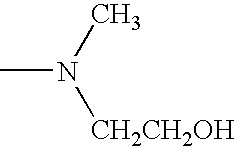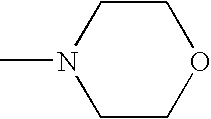Sustained release compositions and controlled delivery method
a composition and composition technology, applied in the direction of synthetic resin layered products, weaving, bandages, etc., can solve the problems of sharp decline in active agent concentration, inadequate treatment as active agent concentrations decrease, and sharp increase in active agent concentration to a peak
- Summary
- Abstract
- Description
- Claims
- Application Information
AI Technical Summary
Benefits of technology
Problems solved by technology
Method used
Image
Examples
example 1
Adsorption capacity is the maximum weight percent of a liquid added to an adsorptive substrate (powder) until a very stiff, putty-like paste is produced. The adsorption capacity was determined by ASTM Method D 281-31, and the method disclosed in U.S. Pat. No. 4,962,170, incorporated herein by reference. In particular, the adsorption capacity is calculated from the weight difference of the powder containing the liquid and the dry powder according to the equation:
AdsorptionCapacity (%)=(wt. powder+liquid)-(initial wt. powder)×100(wt. powder+liquid)Adsorption capacity determination:Water (wt %)Mineral Oil (wt %)Cotton Fibers80.170.6Wood Fibers78.366.7
example 2
Wood fibers of median particle size 20 microns were loaded with an isopropanol / marigold extract solution in an amount of 2 grams of solution per gram of wood fibers, then dried in a vacuum oven at 40° C. to evaporate the isopropanol. The resulting dry sustained release composition was an orange, fine powder, containing 20 wt % entrapped marigold extract, i.e., 0.25 grams of marigold extract per gram of wood fibers. Marigold extract is a vitamin supplement and contains 30% of lutein which is a sensitive carotenoid. The entrapped marigold extract delivered as free-flowing powder was stabilized against oxidation and degradation by light.
example 3
Example 2 was repeated, except that cotton fibers of median particle size 5 microns were used. The same results were obtained.
PUM
| Property | Measurement | Unit |
|---|---|---|
| particle size | aaaaa | aaaaa |
| contact angle | aaaaa | aaaaa |
| median particle size | aaaaa | aaaaa |
Abstract
Description
Claims
Application Information
 Login to View More
Login to View More - R&D
- Intellectual Property
- Life Sciences
- Materials
- Tech Scout
- Unparalleled Data Quality
- Higher Quality Content
- 60% Fewer Hallucinations
Browse by: Latest US Patents, China's latest patents, Technical Efficacy Thesaurus, Application Domain, Technology Topic, Popular Technical Reports.
© 2025 PatSnap. All rights reserved.Legal|Privacy policy|Modern Slavery Act Transparency Statement|Sitemap|About US| Contact US: help@patsnap.com



